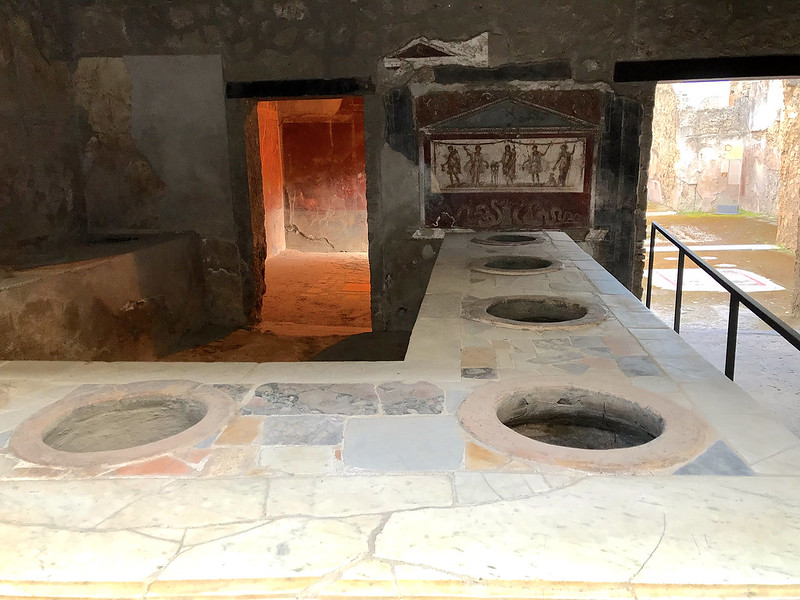In Stone and Story
Early Christianity in the Roman World
Chapter 14: Business & Success
Photo Gallery
Photos 14.1 and 14.2
Figure 14.8 of In Stone and Story depicts a frescoed shrine overlooking the countertop of a fast-food and wine bar. Photo 14.1 shows more of the context in which that frescoed shrine is found, including the countertop of the bar and the “dolia” in which the bar’s items for sale were kept. The photo also shows back rooms where customers could eat in slightly more formal settings. Photo 14.2 illustrates another strategy for protecting a business — not putting deity on display within the business premises (as in photo 14.1) but locating the deity above the entryway of the business. The shrine for a deity is clearly located directly above the bar’s countertop.
Photos 14.3 through 14.6
Photo 14.3 shows three frescos painted onto the wall of a small bar (at 6.10.19). There are no deities or spiritual beings or mythic scenes in these frescos. The scenes depict moments in ordinary life. In the scene on the far left, gamblers throw dice (photo 14.4). In the middle scene, a slave serves a customer (photo 14.5). The scene on the far right is hard to decipher now (photo 14.6), but early records of it clearly indicate that it depicted people sitting together (with one drinking a cup of wine to his mouth), with various foods hanging from a wall near them.
Photo 14.7
A bar near the Herculaneum Gate into and out of Pompeii (at 6.1.2) has a small seating section that extends into the pedestrian pavement, allowing more customers to frequent the bar at any time — a fairly unique and somewhat surprising architectural feature.
Photo 14.8
This wine shop in Herculaneum is typical of small Vesuvian workshops and business premises. The shop itself is open to the street at ground level; the amphorae containing the wine was held in the wooden racks at the back of the shop; a ladder leads up to a higher floor, which probably served as a small bedroom for the workers and their family members.
Photos 14.9 and 14.10
To ensure that grain was bought and sold fairly, a measuring station was placed in the forum of Pompeii (photo 14.9), allowing for a degree of exactitude when measuring out quantities of produce. (Compare the saying of Matt 7:2 — “with the measure you use, it will be measured to you.”) When business was conducted through contracts, parties in the business agreement often used stamp rings (photo 14.10) to validate the contract, pressing their identification stamps into wax tablets to signal their approval of the contract.
Discussion Questions
- A variety of voices can be heard within the New Testament regarding economic issues. Discuss the spread of voices regarding wealth and poverty. Discuss the spread of voices regarding engagement in the broader socio-economic structures. How do these voices compare to other voices today?
- Chapter 14 of In Stone and Story uses Paul’s encounter with the silversmiths of Ephesus to illustrate how early Christian devotion engaged with the surrounding cultures. Using your knowledge of Paul, how might he respond to contentious financial and economic issues today (e.g., payday lending institutions, casinos, corporate exploitation)?

